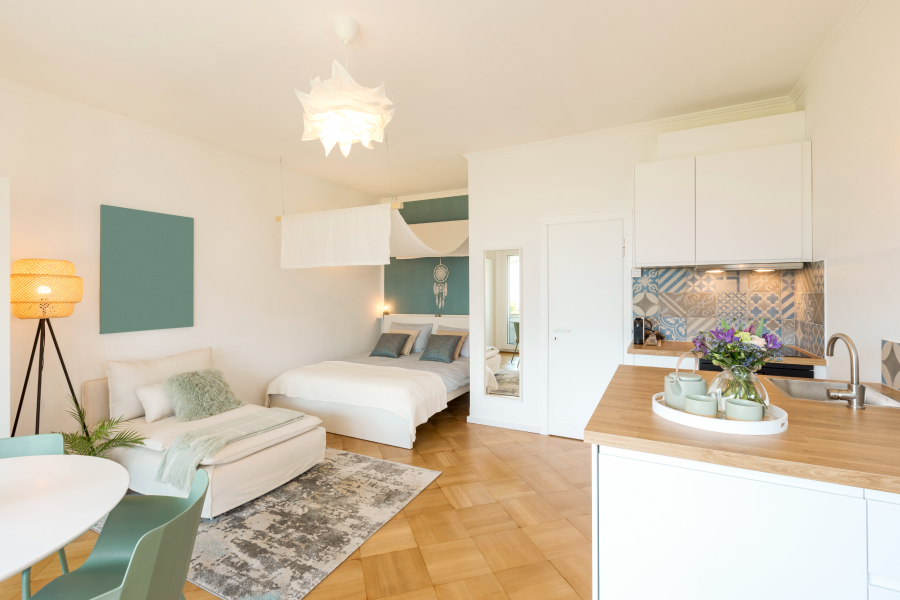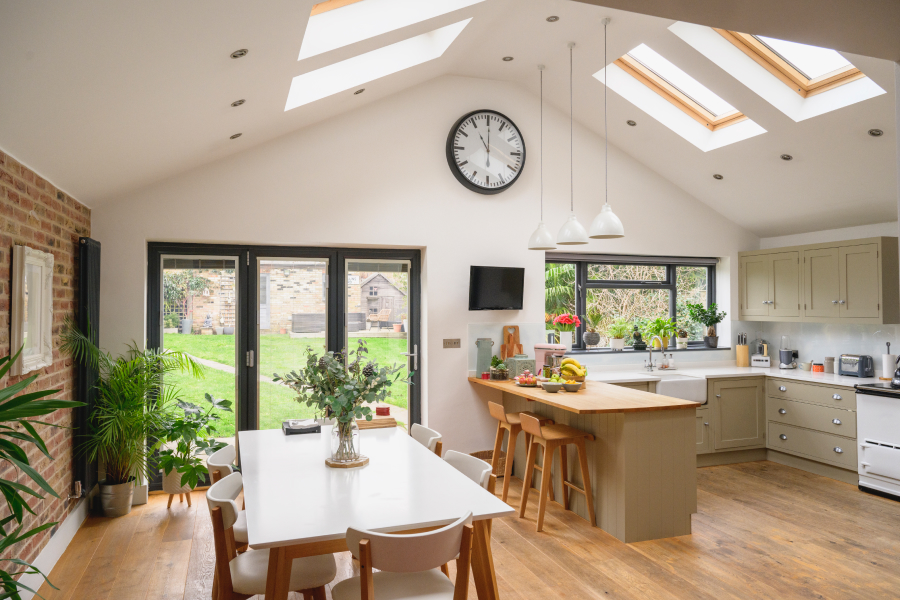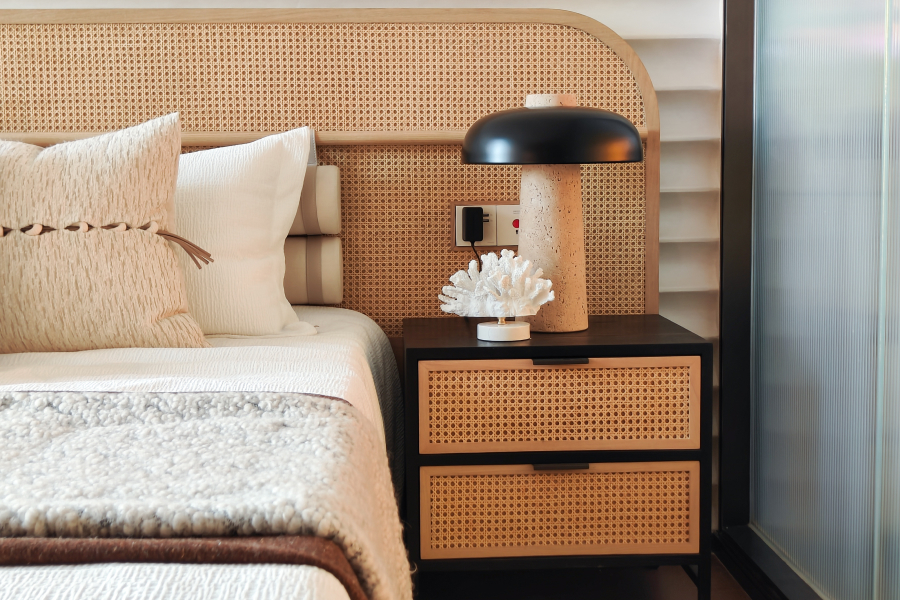What experts say is the key to an odor-free kitchen, plus more room-by-room advice.

Open concept homes can feel airy and spacious, but they can be relatively difficult to keep clean. The lack of walls means clutter is inevitably out in the open, and suitable storage space is a precious resource.
Luckily, there are tricks to conquering your cleaning routine and building better organizational habits that work with your open floor plan. We asked professional organizers and home décor experts for their best tips for tidying and arranging any open concept home, including a studio apartment.
If you’re ready to stop resenting those dirty dishes you can see from your living room couch, keep reading.
Here’s what the pros had to say.

1. Declutter first, buy storage second
When piles of miscellaneous items — like your magazine subscription from last year or those shoes you meant to return to the store — start accumulating around your home, it can be tempting to buy bins to stash it all away for good. But before you do, first take time to assess what you have and empty out your space as much as possible.
Keeping your space clean in an open concept home is about having “a less is more attitude,” Utah-based designer and home décor influencer Allison Campbell says. The simple act of decluttering can make a space instantly feel bigger and more put together.
This also includes thinking about how your décor and color choices play a role in how “cluttered” your space may feel. Campbell recommends adopting a neutral color palette in an open floor plan to allow for the eye to sweep over the space, rather than getting caught on bold patterns or colors. If you love color, stick to just one to two colors in your décor and eliminate anything that falls outside of that framework.
2. Keep your projects mobile
Instead of leaving an unfinished project on the kitchen table for weeks, use a rolling cart to store away projects more easily.
“Rolling carts are a great solution for smaller projects,” Emily Mass, professional organizer and owner of Spaces by Emily, says, because you can roll it into your work space, whether that’s in your living room or at your kitchen table,and quickly pack up your supplies into the cart and roll it back into a closet when you’re taking a break.
Dividing up your rolling cart in an organized way helps, too. “Having designated bins for specific projects such as sewing, sorting mail, crafting, or literally anything is good so that you can pull the bin out and work, and then put it away,” she says. Designate it as the “project” bin since projects can change often.
Try this next time you’re wrapping gifts for the holidays and want to avoid having miscellaneous ribbon and scissors lying around your main living space.
3. Prioritize your cleaning list by zone
Deep cleaning a whole room at once can feel like a lot. In your open floor plan, the living, dining, and kitchen area are virtually one large room. Don’t let it intimidate you — designate your list of cleaning tasks into smaller zones that feel manageable to you.
“It helps to break down cleaning by tackling one space at a time,” Mass says. Sometimes, even just focusing on a single counter, drawer, or cabinet can be helpful. “By finishing one smaller space, it usually gives more momentum to take on another space,” she added.
Pro tip: Never start with the scariest space first. Instead, Mass says, start with something small and easy.
Save more routine cleaning tasks, like doing dishes, for certain times of the day or week on a regular schedule. Mass says she likes to “‘put the home to bed’ each night,” which includes making sure the counters and floors are clean and everything is in its place before she ends her day.
4. Divide and conquer (your space)
Dividing up your open concept space can help hide clutter when you don’t have time to clean, or might help inspire a more organized divide-and-conquer method (see tip above).
Anna Bauer, founder of Sorted & Co., suggests using a folding rattan room divider. “It’s a chic and retro way to divide a space without making it seem old fashioned,” she says. An added bonus: The lightweight vine that is a defining quality of rattan makes it easy to put the divider away when it’s not needed.
If you want to create more permanent zones without blocking too much light or airflow to your space, plants make a great alternative. “You’ll want to choose plants that are very low maintenance and can grow fairly tall, like Snake plants or Monstera plants,” she says. Pair them with plant stands that are tall or mid-height, depending on the amount of privacy you want.

5. Prevent kitchen odors before they happen
With an open floor plan, kitchen smells won’t stay in your kitchen.So if you don’t already have one, consider investing in a range hood above your oven. It plays down cooking smells by using a blower to pull up smoke, grease and moisture.
“Use an oven fan or if you don’t have one, a regular fan,” Millie Naor, professional organizer and founder of New York-based Bella Organizers, says. Natural deodorizers like baking soda and lemon juice can help, in addition to keeping a window cracked open while you’re cooking.
Cooking isn’t the only culprit when it comes to unpleasant odors.“People are usually surprised by this, but most of the smells come down to neglect for your appliances,” Lisa Jacobs, professional organizer, CEO and founder of Imagine It Done NY, says. “Any place that harbors water will eventually breed mildew if not properly and frequently cleaned.”
To avoid this, make sure you clean your garbage disposal and the deeper areas inside of your dishwasher with white vinegar at least once a month or more often if you’re up to it.
Finally, don’t overlook your trash. Jacobs recommends installing your trash bin into a kitchen cabinet under the sink, instead of using a standalone bin that will take up more room and create more opportunities for bad smells in your space.
Open floor plan tidying hacks: A room-by-room guide
Kitchen
A quick decluttering trick for when you have guests over: Save room in your upper kitchen cabinets for storing countertop appliances, like juicers or dehydrators. This keeps your countertops clean and your kitchen will instantly feel more spacious and easy on the eyes.
Living room
Make your décor do double duty; a coffee table or ottoman with built-in storage can help you stow miscellaneous items, like kids’ toys, blankets, books, or even mail, more easily and quickly.
Dining area
If you use your dining room table as a catchall for your keys, wallet, sunglasses and stray papers, break this habit by designating one or two drop-off zones in your home that are in high-traffic areas, like near your front door, and scheduling times to regularly go through them.
Bedroom
If you’re living in a home where your bedroom is part of the open concept, use the space underneath your bed to store items you won’t need regular access to. This can be anything from clothes and shoes that aren’t in season, to special occasion dishware, to kids’ toys you’re rotating out.
Hide it all in style with a duvet cover that’s at least one size larger than your bed (so if you have a queen, buy a king-sized duvet cover). This ensures your bedding covers the sides of your bed all the way down to the floor.

For nightstands,look for options that have drawers instead of shelves — that way, when it’s time to do a quick clean up, you can easily toss things in a drawer out of sight.
Entryway
Your shoe rack may have looked cute online, but it’s not doing you any favors if you can see everyone’s shoes all over the floor from across the room. Swap a shoe rack for a stylish cushion bench with a hinged top that has storage inside for all of your shoes, making it a breeze to stow footwear out of sight.
While this guide is filled with helpful tips, the options are endless when it comes to cleaning and organizing your home. Check out this home maintenance checklist and these small space storage tips for more inspiration.

